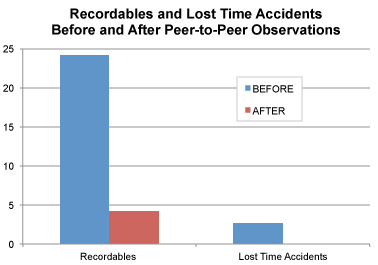Removing Barriers to Achieving Exceptional Safety
Truly effective champions of behavior-based safety (BBS) play many important roles from attaining employee buy-in, to ensuring management support, to sustaining ongoing participation and improvement. But, according to David Andrews, the full-time safety champion for EuroKera North America, one of the most important aspects of the job is keeping the BBS consultant out of trouble. Not to imply by any means that a BBS consultant is an accident waiting to happen—Andrews refers to the key activity of sharing information about navigating the culture of the organization. It is not that EuroKera is particularly political, but all companies have norms or unwritten rules that a new consultant can’t immediately pick up on. “I can say, ‘If we need to get this done, then we should talk to this person first, get their buy-in, and then we’ll go talk to this one.’ For example, some people say, ‘That’s my area; you should have talked to me first!’ Certain people you have to have data for; certain people you have to appeal to their emotions. You have to know about an individual’s personality so you know how to talk to them to get your point across,” Andrews explains.
 Andrews is the environmental, health, safety and recycling coordinator for EuroKera North America. EuroKera, established in 1995 and located in Greenville, South Carolina, is the leading glass-ceramic cooktop manufacturer on this continent. The company’s 150 employees produce approximately 2.5 million cooktops per year for major appliance manufacturers. A few years ago, the facility decided to involve its employees in a safety effort—to address incident and lost time accidents—by offering bonus incentives for reporting unsafe workplace conditions. The effort included data collection and scorecards, setting a good standard for what was to come. “After we had addressed all of the reported conditions, we noticed that people were reporting behaviors, like someone not wearing their safety glasses. That’s when we started looking for a BBS consultant,” says Andrews.
Andrews is the environmental, health, safety and recycling coordinator for EuroKera North America. EuroKera, established in 1995 and located in Greenville, South Carolina, is the leading glass-ceramic cooktop manufacturer on this continent. The company’s 150 employees produce approximately 2.5 million cooktops per year for major appliance manufacturers. A few years ago, the facility decided to involve its employees in a safety effort—to address incident and lost time accidents—by offering bonus incentives for reporting unsafe workplace conditions. The effort included data collection and scorecards, setting a good standard for what was to come. “After we had addressed all of the reported conditions, we noticed that people were reporting behaviors, like someone not wearing their safety glasses. That’s when we started looking for a BBS consultant,” says Andrews.
A manufacturing process that includes transporting, melting, pressing, cutting and edging, screen-printing, heat treatments, and hole drilling of glass carries great potential for a variety of incidents. EuroKera’s management team also considered a variety of behavior-based safety specialists, but some of the specialists’ approaches were too rigid, and as Andrews saw it, possibly not practical, especially in the area of behavior observations. “Look at it this way,” he says. “If a police officer tells you he is going to follow you for the next ten miles to observe your driving, you’re going to drive your best aren’t you? That doesn’t mean you’re going to do that when he isn’t watching. Also, we didn’t want a one-size-fits-all approach. We wanted a process that was tailored to EuroKera, because our culture is very unique.”
They found an adaptable BBS approach with Aubrey Daniels International (ADI). Bart Sevin, Ph.D., a behavioral safety consultant with ADI, helped the group design a system that fit the facility’s needs while also shaping safe behaviors to habit strength. “David is an extraordinary site champion,” says Sevin. “He knows everyone in the plant well, he is trusted and respected by people at all levels, and he was instrumental in helping me effectively negotiate the politics of the plant. His guidance helped me avoid more than a few pitfalls and greatly facilitated the successful implementation of the BBS process.”
“Bart trained everyone in the behavior basics, so that everyone knew what to expect and didn’t panic when people started writing stuff down,” says Andrews of the peer-to-peer behavioral safety observations. EuroKera adopted a simple process in which peers take a few minutes to look over at a co-worker to see if he or she is engaging in a pinpointed behavior such as using personal protective equipment. They then mark a checklist and provide real-time feedback. Each group also tracks and charts its own data. Importantly, the primary focus is on observations and feedback, rather than on lagging indicators such as reduced incident rate. The entire plant participates in the safety initiative with the same celebration budget allotted for every level of the organization. After a group meets a subgoal or goal, a short meeting recounting the reason for the gathering and thanking everyone for their efforts precedes a celebration designed by the participants. “Probably one of the best things we’ve done is keeping the celebrations simple,” says Andrews. “We don’t have the escalating celebrations that I’ve seen turn into nightmares for numerous companies.”
Andrews shows up for these events even in the wee hours of the evening morning, often stopping by an all-night restaurant to pick up the food that the late shift has ordered for its celebratory meal. This effort is greatly appreciated by those who know Andrews works during the day; yet he considers their achieved safety milestones valuable. “They figure if the celebration is important enough for me to get out of bed at one o’clock in the morning and come in to meet with them, then the safety observation cards are important enough for them to do,” Andrews comments.
The three years that Andrews has taken on the role of internal safety champion for this EuroKera facility have provided him with lessons learned that he shares in presentations to other facilities—lessons not only for designated safety champions but for safety leaders. According to Andrews, a safety leader can be anyone who is willing to continually encourage and reinforce others to be proactively safe. As he puts it, “the devil is in the details.” For example, good safety leaders ask general questions about BBS such as “How is BBS going?” or “Are you doing observations?” However, exceptional leaders ask specific questions: “What did you do to improve BBS today?” “Who did you talk to and what did you say?” “What have you done to hold those who report to you accountable for performing their role in BBS?”
One of those exceptional leaders has been Bill Mountain, former plant manager. “He embraced BBS as plant manager and when he was promoted to president continued to be active in the process,” Andrews explains. “He filled out a card every day. He went out on the floor and conducted safety observations. His ongoing participation showed that he was behind it.”
Andrews also readily lists the “high-impact” behaviors of an internal safety champion, a few of which are as follows:
- Frequently contact and coach core teams, managers, and supervisors
- Directly and indirectly facilitate the effective use of antecedents and consequences with people at all levels (accountability)
- Track outcomes and success measures, and give frequent updates to people at all levels
- Ensure consistency in all aspects of the process
- Proactively bring potential issues and problems to leadership
 Andrews categorizes “keeping the consultant out of trouble by introducing him to the inner workings of the culture” under the high-impact behavior of “facilitating barrier removal.” This means removing barriers that might impede both the implementation of BBS and the achievement of safety goals. Therefore, in addition to sharing information with the consultant about the internal culture, he may facilitate the relocation of an earplug station to help a team achieve the behavioral pinpoint of wearing earplugs at habit strength.
Andrews categorizes “keeping the consultant out of trouble by introducing him to the inner workings of the culture” under the high-impact behavior of “facilitating barrier removal.” This means removing barriers that might impede both the implementation of BBS and the achievement of safety goals. Therefore, in addition to sharing information with the consultant about the internal culture, he may facilitate the relocation of an earplug station to help a team achieve the behavioral pinpoint of wearing earplugs at habit strength.
“I don’t have disciplinary authority. I can’t say to do this or else,” says Andrews. “I have to help sustain this process by finding a way of interacting with people that clicks with them about how important this is.” For example, when Andrews shares data as to the impact of BBS, he not only discusses the numbers, but personalizes the information with details such as, “This is how many people got stitches this year as opposed to last year.”
“You have to be able to show people that it’s working!” he asserts.
The data is progressively easier to share. Since the day EuroKera’s employees started the process three years ago, as the participation in conducting safety observations rose, the recordables and lost time accidents diminished. When the facility began the BBS process, the recordables stood at 24.2 and the lost time accidents at 2.69. Currently 97 percent of the frontline employees conduct peer-to-peer observations and feedback. With a recordable rate at 4.2 and lost time accidents at zero, Andrews doesn’t think the improved safety record is a coincidence. He concludes, “We’ve made tremendous progress with BBS.”


